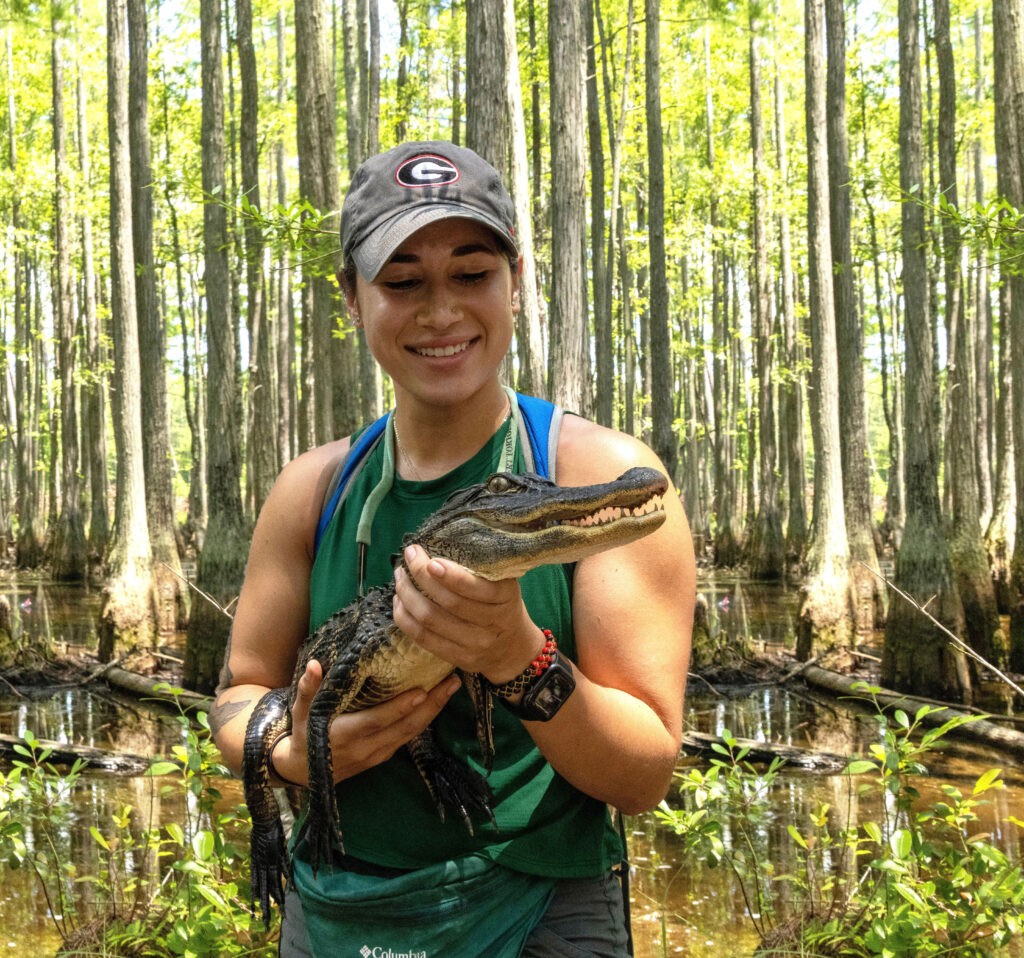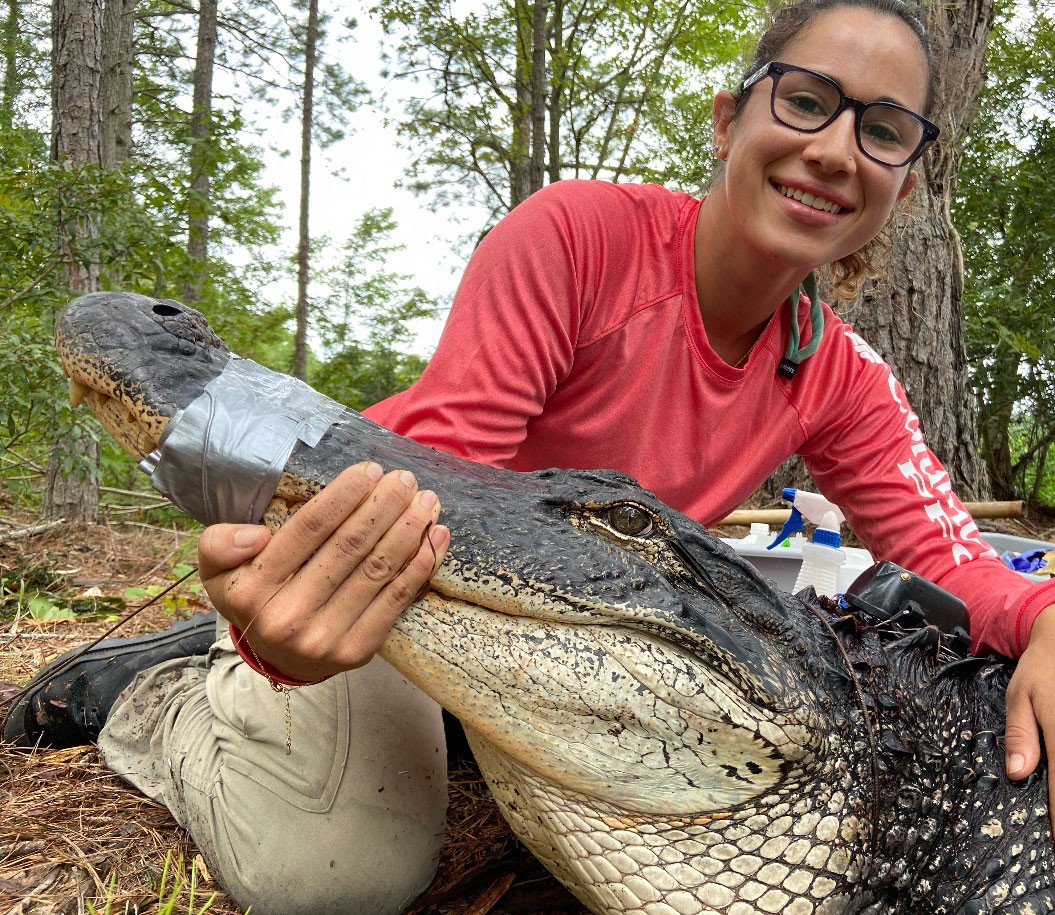Laura Kojima was 15 years old the first time she held an alligator. The California native and Mexican American had decided to visit New Orleans in lieu of having a quinceañera.
“I don’t want to have a party,” she told her mom. “I just want to go to a swamp.”
In Louisiana, she discovered that she loved the culture, the ambiance and the humidity too. And it was during a bayou swamp tour that she met the alligator—a juvenile not more than 2 feet long—not knowing it would be the first of many.
“It was amazing,” she said.
A decade later, Kojima’s alligator encounters are decidedly more circumspect. Now a UGA graduate student at the Savannah River Ecology Lab and the Odum School of Ecology, she is examining the levels of mercury found in alligator tail muscle. She’s also assessing the concerns for contaminant exposure associated with the hunting and consumption of alligators that travel between different areas.
To conduct her research, Kojima captures alligators that are much bigger than the one she met in the bayou. Adult alligators measure up to 14 feet and weigh up to 1,000 pounds.
“I am very cautious in my fieldwork, and I am 100% aware of how incredibly strong they are,” she said. “I choose my team very selectively. We always have our guard up.”
Using wooden bait traps, Kojima and her team bring an alligator on land, secure it and gather measurements and samples before releasing it. They also attach a GPS transmitter that sends location information in real time, allowing her to monitor the alligator’s movements.
Location information is essential for the first question she’s asking for her master’s thesis project, which is supported by a 2021 National Science Foundation Graduate Research Fellowship: What is the risk of hunting alligators that originate from the Savannah River Site and move up or down the Savannah River?
A former nuclear facility managed by the Department of Energy, SRS is not accessible to the public, but wildlife can move off the site and onto public hunting grounds. With alligator hunting on the rise for sport and for sustenance, monitoring their mercury levels provides information that can guide hunting advisories.

Kojima’s second research question involves evaluating mercury levels and movement behaviors to see if there’s a relationship between the two. At SRS the alligators occupy two manmade lakes, previously used as coolant ponds, that contain differing levels of contaminants. “Do we see alligators in one lake, where mercury is notably higher, having more random or unexpected behavior? That’s the next part of my project that I’m diving into.”
Alligators are a good bioindicator species for monitoring environmental health because, as apex predators, they’re eating fish and other animals that accumulate contaminants. “Through these animals, we’re able to see how certain levels change over time and how they compare within different locations,” she said.
Although she loves working with alligators, Kojima doesn’t want to limit her options. For her master’s project, she’s working as an alligator ecotoxicologist, but she really considers herself to be a herpetologist, a biologist that works with all reptiles.
“I really love working with crocodilians, but it’s a narrow field to be in,” said Kojima, who plans to graduate in May 2023 and hopes to work for a state agency like California’s Natural Resources Agency or Department of Fish and Wildlife. “I feel like there’s more that I can do outside of the crocodilian world. I like the idea of a broader conservation herpetological job.”
Ideally that work would contain an educational component, something she’s passionate about. Kojima is active on Twitter (@LauraKojima) and with Skype a Scientist, a nonprofit that connects scientists with elementary school classes. Last year, UGA’s Marine Institute invited her to talk virtually with K-12 kids about her work with alligators, and this year she spoke to college classes at two different universities about careers in wildlife and herpetology.
Kojima appreciates having opportunities to engage with younger people in the field—and those young enough that they haven’t chosen a path.
“As a woman of color navigating STEM, it’s important for me to show a little bit of representation,” she said. “Because I know there are, especially on the Georgia coast, Hispanic communities. We’re still probably one of the smallest minorities in the field of ecology. I think it’s only like 3% or something.”
Assuming that type of public role isn’t always comfortable, she said, but it’s important.
“When I saw how many people saw the BBC video, it made me a little uneasy, you know?” Kojima said. “But it’s what you have to do to reach the one or two people who are going to be like, ‘Oh, she’s doing that, and she looks like me and comes from a similar background as me. Maybe I’ll be able to do it too.’ Because I would’ve loved to see that growing up, and I never did.”
Kojima enjoys the solitude of her field work.
“It’s just me and my crew, and we’re out on a lake by ourselves, and that’s just unbelievable. I’m so grateful for that,” she said. “It’s just nice being able to be on a boat on a private lake and catch alligators. That’s what I enjoy doing with my time. It’s a lot of fun.”

